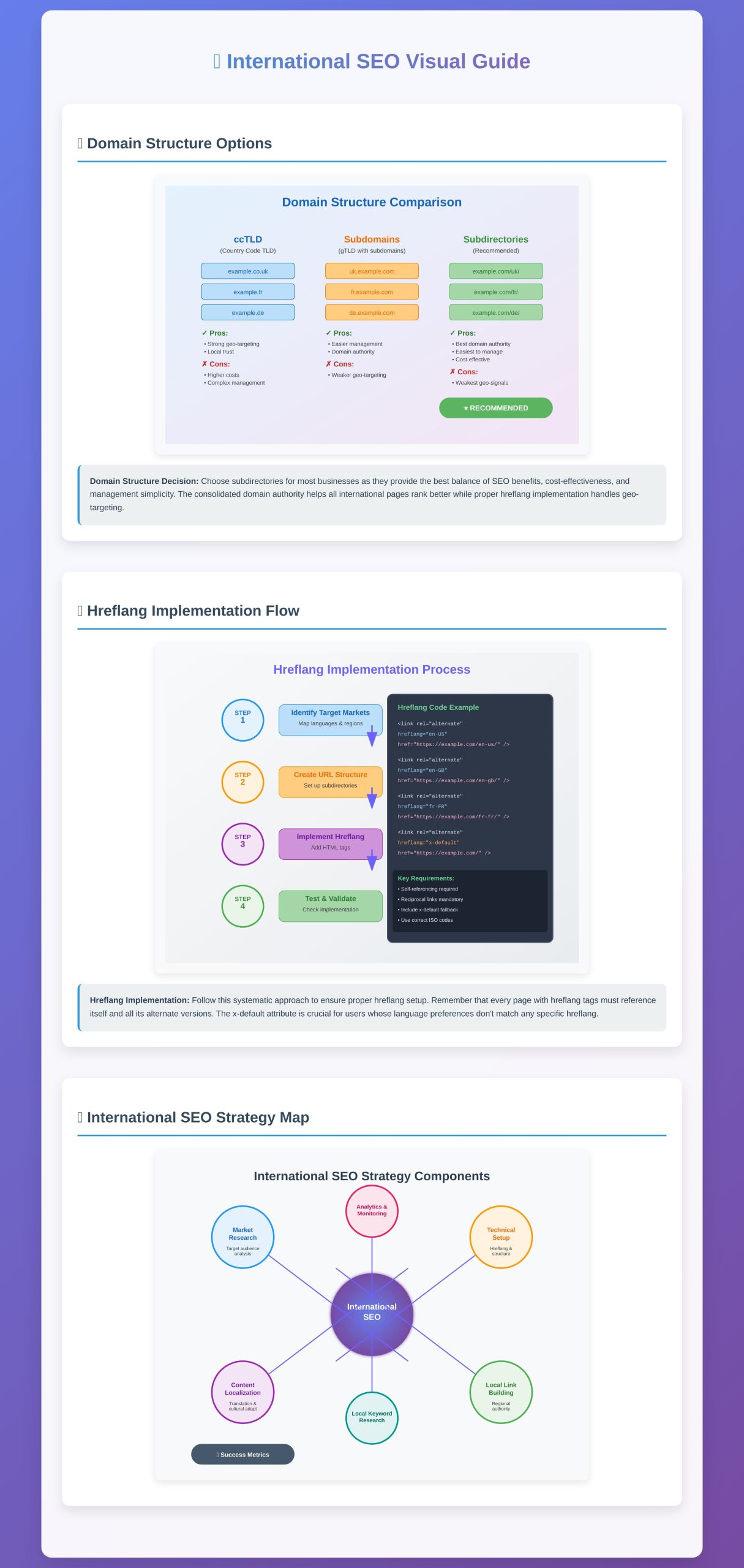International SEO is the strategic process of optimizing your website to rank effectively in search engines across multiple countries and languages. Unlike traditional SEO that focuses on a single market, international SEO involves adapting your content, technical structure, and marketing approach to cultural and linguistic differences while ensuring search engines can properly identify and serve the right content to users in different regions.
The goal is to create a seamless experience for users worldwide while maximizing your visibility in global search results. This requires careful consideration of language preferences, cultural nuances, search behaviors, and technical implementation.
Why International SEO Matters in 2025
The digital landscape has become increasingly global, with businesses expanding beyond their home markets to reach international audiences. With over 4.8 billion internet users worldwide speaking different languages and having unique search behaviors, international SEO has become essential for:
- Expanding market reach: Access new customer bases in different countries
- Improving user experience: Provide content in users’ preferred languages
- Avoiding duplicate content issues: Prevent search engines from penalizing similar content across regions
- Maximizing ROI: Increase revenue potential through global visibility
- Competitive advantage: Outrank competitors who haven’t optimized for international markets
Key Components of International SEO Strategy
1. Market Research and Target Audience Analysis
Before implementing any technical changes, conduct thorough research to understand:
- Language preferences: Which languages are spoken in your target markets
- Cultural differences: How cultural factors influence search behavior and content preferences
- Search engine preferences: Which search engines dominate in different regions (Google, Baidu, Yandex, etc.)
- Competitor analysis: How competitors are approaching international SEO in your target markets
- Local search trends: Popular keywords and search patterns in each region
2. Website Structure and Domain Strategy
Choose the right technical foundation for your international site:
Domain Structure Options
Country Code Top-Level Domains (ccTLDs)
- Format: example.co.uk, example.fr, example.de
- Pros: Strong geo-targeting signals, local trust
- Cons: Higher cost, complex management, diluted domain authority
Subdomains with Generic Top-Level Domains (gTLDs)
- Format: uk.example.com, fr.example.com, de.example.com
- Pros: Easier management, consolidated domain authority
- Cons: Weaker geo-targeting signals
Subdirectories with gTLDs
- Format: example.com/uk/, example.com/fr/, example.com/de/
- Pros: Strongest domain authority consolidation, easiest to manage
- Cons: Weakest geo-targeting signals
Best Practice Recommendation
For most businesses, subdirectories with proper hreflang implementation provide the best balance of SEO benefits and manageable complexity.
3. Hreflang Implementation
Hreflang tags are crucial HTML attributes that tell search engines which language and region each page targets. Proper implementation prevents duplicate content issues and ensures users see content in their preferred language.
Hreflang Syntax
<link rel="alternate" hreflang="en-US" href="https://example.com/en-us/" />
<link rel="alternate" hreflang="en-GB" href="https://example.com/en-gb/" />
<link rel="alternate" hreflang="fr-FR" href="https://example.com/fr-fr/" />
<link rel="alternate" hreflang="x-default" href="https://example.com/" />
Implementation Methods
HTML Head Tags Place hreflang tags in the <head> section of every page. This is the most common and recommended method.
HTTP Headers Use HTTP headers for non-HTML files like PDFs:
Link: <https://example.com/en-us/document.pdf>; rel="alternate"; hreflang="en-us"
XML Sitemaps Include hreflang annotations in your XML sitemap:
<url>
<loc>https://example.com/en-us/</loc>
<xhtml:link rel="alternate" hreflang="en-us" href="https://example.com/en-us/" />
<xhtml:link rel="alternate" hreflang="fr-fr" href="https://example.com/fr-fr/" />
</url>
Common Hreflang Mistakes to Avoid
- Missing reciprocal links: If page A links to page B, page B must link back to page A
- Incorrect language codes: Use ISO 639-1 format (en, fr, de, not EN, FR, DE)
- Missing x-default: Always include an x-default version for users whose language/region isn’t specified
- Self-referencing errors: Each page must include a hreflang tag pointing to itself
- Broken or redirected URLs: All hreflang URLs must return 200 status codes
4. Content Localization Strategy
Effective international SEO goes beyond translation—it requires true localization:
Content Adaptation
- Cultural sensitivity: Adapt content to local customs, values, and preferences
- Local references: Include region-specific examples, case studies, and testimonials
- Currency and measurements: Use local currency, measurement units, and date formats
- Legal compliance: Ensure content meets local regulations and requirements
Keyword Research for International Markets
- Local keyword tools: Use region-specific keyword research tools
- Native speaker input: Work with native speakers to understand search intent
- Seasonal considerations: Account for different seasons and holidays in various regions
- Search behavior differences: Understand how users in different regions phrase their queries
Content Quality Standards
- Avoid machine translation: Invest in professional translation services
- Native content creation: Consider creating original content for each market
- Regular updates: Keep localized content fresh and relevant
- Quality assurance: Implement review processes with local experts
5. Technical SEO Considerations
Server Location and CDN
- Geographic hosting: Consider hosting content closer to your target audience
- Content Delivery Networks: Use CDNs to improve page load speeds globally
- Server response times: Optimize for fast loading in all target regions
Mobile Optimization
- Responsive design: Ensure consistent experience across devices
- Mobile-first indexing: Optimize for mobile since many international users primarily use mobile devices
- Local mobile preferences: Consider region-specific mobile behaviors and preferences
Page Speed Optimization
- Image optimization: Compress images without losing quality
- Code minification: Minimize CSS, JavaScript, and HTML
- Browser caching: Implement proper caching strategies
- Third-party script optimization: Minimize impact of external scripts

6. Local Link Building and Authority Building
Regional Link Building Strategies
- Local directories: Submit to relevant local business directories
- Local media outreach: Build relationships with regional publications
- Partnership opportunities: Collaborate with local businesses and organizations
- Localized content marketing: Create content that resonates with local audiences
Building Local Authority
- Local citations: Ensure consistent NAP (Name, Address, Phone) information
- Regional social media: Maintain active presence on popular local platforms
- Local events and sponsorships: Participate in regional activities
- Community engagement: Build relationships within local business communities
Implementation Checklist
Planning Phase
- [ ] Conduct market research for target countries
- [ ] Analyze competitor international SEO strategies
- [ ] Define target languages and regions
- [ ] Choose appropriate domain structure
- [ ] Create content localization plan
Technical Implementation
- [ ] Set up proper URL structure
- [ ] Implement hreflang tags correctly
- [ ] Configure geo-targeting in Google Search Console
- [ ] Set up region-specific XML sitemaps
- [ ] Optimize server configuration for international users
Content Development
- [ ] Translate and localize content professionally
- [ ] Conduct keyword research for each target market
- [ ] Create region-specific landing pages
- [ ] Develop local content marketing strategy
- [ ] Implement local schema markup
Ongoing Optimization
- [ ] Monitor international search performance
- [ ] Track local rankings and traffic
- [ ] Analyze user behavior by region
- [ ] Continuously improve content based on performance
- [ ] Stay updated with local search algorithm changes
Measuring International SEO Success
Key Performance Indicators (KPIs)
- Organic traffic by region: Track traffic growth in each target market
- Keyword rankings: Monitor position improvements for localized keywords
- Conversion rates: Measure how well international traffic converts
- User engagement: Analyze bounce rates, time on site, and page views by region
- Local search visibility: Track performance in local search results
Analytics and Reporting
- Google Analytics: Set up geographic and language-based segments
- Google Search Console: Monitor performance by country and search queries
- Local search tools: Use region-specific SEO tools for deeper insights
- Regular audits: Conduct periodic technical and content audits
Common Challenges and Solutions
Challenge 1: Duplicate Content Issues
Solution: Implement proper hreflang tags and create unique, localized content for each region.
Challenge 2: Technical Complexity
Solution: Start with one or two target markets and gradually expand. Use website internationalization tools to simplify management.
Challenge 3: Resource Constraints
Solution: Prioritize high-potential markets and consider automated translation tools for initial implementation, followed by professional localization.
Challenge 4: Maintaining Consistency
Solution: Develop clear brand guidelines and content standards that can be adapted across regions while maintaining core messaging.
Future of International SEO
As we move through 2025, several trends are shaping the future of international SEO:
- AI-powered translation: More sophisticated translation tools that understand context and culture
- Voice search optimization: Growing importance of optimizing for voice queries in different languages
- Mobile-first indexing: Continued emphasis on mobile optimization for international audiences
- Local search integration: Increased importance of local search signals for international visibility
- Personalization: More granular targeting based on user preferences and behavior
International SEO in 2025 requires a comprehensive approach that combines technical expertise, cultural understanding, and strategic thinking. Success depends on proper planning, careful implementation, and ongoing optimization based on performance data.
By following the strategies and best practices outlined in this guide, businesses can effectively expand their global reach, improve user experience for international audiences, and achieve sustainable growth in international markets. Remember that international SEO is an ongoing process that requires continuous monitoring, testing, and refinement to maintain effectiveness across different regions and evolving search algorithms.
Sharing is Caring!
